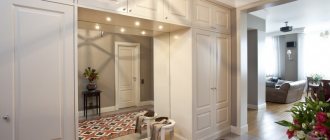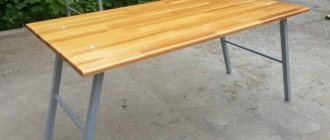Peculiarities
Almost every woman dreams of a large dressing room. However, not every apartment has the space to arrange storage space for clothing and shoes. Most even small living spaces have storage rooms. As a rule, they contain items from the wardrobe, as well as various equipment. If you try really hard, you can find a completely different use for such a room, without spending a lot of material resources and time.
Equipping an apartment with a small dressing room eliminates several issues at once - you no longer need to confuse your family with buying a new wardrobe, all things will be stored in a certain order, and additional space will appear in the bedroom or living room for new furniture. Another option is to simply divide an existing room into zones. To design a wardrobe storage space, 2 square meters will be enough. m.
It is important that the storage space is as functional and spacious as possible. Pay attention to creating elements of comfort.
The main purpose of a small dressing room is to organize a huge number of seasonal and everyday items. The decisive factor is that it is not at all necessary to hire a designer to design such a storage system; it can be made with your own hands from the pantry.
How to plan a dressing room in the attic in a private house (+ photo)
The attic is not a full second floor, but this room cannot be considered an attic. Unlike a cold attic, an attic can be lived in because it is insulated and equipped with heating and ventilation systems, and it also has large windows that provide natural light.
The design of the room has certain specifics. The room has a sloping ceiling due to the slope of the roof. The height of the attic walls, up to which furniture can be placed, is 0.8–1.5 meters.
The difficulty of creating an interior in the attic can at the same time be considered an advantage. On the one hand, the need to make custom-made furniture according to individual sizes involves significant expenses. However, the design is exclusive and modern.
Typically, the attic is used for an office or nursery, which does not require tall furniture. Making a dressing room out of this room is also a good solution.
- The clothes and shoes of all family members will be collected in one place, so you no longer need to look for them in different closets.
- To organize storage of things in the attic, ordering capital furniture of an unusual design is not at all necessary. Installing rods with hangers, open mobile shelves and drawers will be quite sufficient. Ease of finding the items you need will ensure easy access.
- When using the entire attic space, you can place a dressing table, a large mirror surface, an ottoman and other furniture in the room.
- One of the advantages of the attic is large windows.
If you find it difficult to imagine how to plan a dressing room, the photo below can serve as a clear example.
The configuration of the internal space is determined by the geometry of the roof. A room in the attic can be rectangular, triangular, with a bay window or loggia, or asymmetrical. When arranging such a room, you can encounter significant difficulties. Furniture for it can either be ordered from professionals or assembled with your own hands according to your own design.
Cabinets and pencil cases in our catalog
Arguments for a dressing room
In the dressing room, things are stored in their own places: sections for dresses, blouses, trousers, jackets and coats. There are drawers for linen and accessories for shoes. Although some refuse it, content with a wardrobe.
Advantages of the dressing room:
- There will be no need for separate wardrobes, chests of drawers, bedside tables, and the apartment will become neater and freer.
- Things are in plain sight, which makes them easier to find than in a closet where you can’t go in and change clothes.
- Fits a lot of shelves and racks.
- You don't have to pack and hang things tightly.
What to place in the dressing room
Dressing room equipment includes:
- Cabinets, pantographs and rods. This is where the design of the entire storage system begins. Shirts, jackets, blouses and dresses will be placed here. The pantograph will allow you to place several rods on top of each other and provide free access to every item.
- Pull-out trouser hangers.
- Drawers. Their purpose is to store bed linen, underwear and accessories. Larger drawers will require dividers.
- Shelves. Stationary or retractable.
- Compartment for ironing board, iron, steam generator and dryer.
- Full length mirror.
- Ottoman or console.
- Boxes and baskets. You can store not only shoes in them, but also magazines, sewing supplies, and out-of-season accessories.
Wardrobe from Gianni Borgonovo
Wardrobe room options
The choice of option is influenced by the location of storage areas according to the owner’s preference, and most importantly, the area of the room.
In linear wardrobes, one wall is used for shelves and brackets. If there is not enough space, sliding doors are located at the front, then the small dressing room turns out to be similar to a wardrobe, up to the ceiling. In another version, the door is on the front side. The width will be 120 cm.
For corner dressing rooms, a corner of the room is fenced off if the adjacent walls have a door or windows, and the corner is empty. Then the shelves are placed at an angle to each other. The central part of the septum is sometimes pushed forward a little.
With a double-row type, the racks are arranged opposite each other, with a width of 60-80 cm between them. The minimum width of the dressing room is 175 cm, suitable for pencil cases.
A U-shaped dressing room, at least 2 m wide, is not suitable for small rooms. Here storage spaces are located on three sides.
In a rectangular clothing storage area, shelves are located along the side walls, on the front wall, and above the door. Width - no less than 120 cm.
An L-shaped small dressing room involves placing things against a long wall and capturing part of the adjacent wall.
Closed
Closed dressing rooms are very bulky structures with hinged or sliding doors, partitions, screens or curtains. They are usually larger in size, and therefore are located in more spacious apartments.
Open
Open wardrobe systems always lack doors and often lack drawers and partitions. The entire system is formed from racks, shelves, rods and hooks, as well as mesh or transparent containers. The compact and convenient design usually extends to the ceiling to make the most of available space. It looks very attractive, but requires constant maintenance of order. You will also have to deal with the rapid accumulation of dust and exposure of clothing to ultraviolet rays.
Open wardrobes are more suitable for small spaces.
How to calculate the size
It is important to calculate the size of the dressing room at the design stage itself. In the future, this will make it easier to arrange this room and help you do it right.
To correctly calculate the size of the dressing room, it is worth dividing all the work into several stages:
- the type and quantity of things to be stored is determined;
- zoning - here you need to determine the level of depth and calculate the size of the width.
Determining the type and quantity of things to store
Many people often have a constant accumulation of things in their apartment, which can occupy most of the premises. So that they are nearby, but do not take up much space, you need to put them in the dressing room. However, a dressing room is not always provided for standard apartments, so you often have to arrange it yourself. You definitely need to evaluate the number and type of things to store.
What things should be stored in this room:
- outerwear - coats, jackets, down jackets, windbreakers. It is imperative to evaluate the size, volume and heaviness of this type of clothing;
- You can put warm sweaters, cardigans, and sweaters in your wardrobe. Especially in the warm season;
- various pants, trousers, dresses, skirts. Typically these items should be hung on hangers;
- The dressing room must have space for storing various shoes of winter, spring, autumn and summer types.
It is worth assessing the total number of things that you plan to put in the dressing room. The size of the dressing room, as well as the number of lockers and drawers for storing clothes, will depend on this condition.
Zoning
The ergonomics of the dressing room should provide a convenient location of all areas in which you can fit a lot of things. But at the same time, this room should not be cluttered.
All things are different, they need to be put away on the upper shelves, hung on hangers, and placed on the lower shelves. For this reason, it is important that the dressing room is divided into zones. It is usually divided into several zones:
- upper zone - this segment is located at a level of 200-250 cm from the floor. These are mezzanines that are designed for folding out-of-season or rarely used clothes. The height of this area should be about 50 cm;
- middle zone - this part is located at a height of 60 to 170 cm from the floor surface. Usually this area has to be used frequently. Here it is recommended to hang things on hangers and rails; you can also install open shelves for sweaters. Bed linen, towels, and accessories should be stored behind closed fronts and in chests of drawers;
- the lower zone is the area that is 70 cm from the floor surface. This area is the most ideal place to store shoes, heavy items, and various bags. This area is not used very often.
Depth detection
Before you begin making calculations, it is worth finding out the specific configuration of the dressing room. The type of configuration should be determined depending on the filling of the internal space of the sections. If a rod with a longitudinal structure parallel to the wall is placed in this room, then the depth of the dressing room should be at least 65 cm.
If hangers are placed around the perimeter of the dressing room, then for a suitable arrangement of shoes, you will need to install a special shoe cabinet below the hangers. The depth of the shoe cabinet should be at least 35 cm.
The optimal size of dressing rooms, namely their depths, must be calculated according to the following scheme:
- it is necessary to add the depth of the shelves, the width of the door and the passage;
- if the room involves the placement of drawers, then the depth is also calculated;
- if the wardrobe cabinets have doors with a sliding structure, then the width of this room will be equal to the width of the cabinet and the passage part;
- The most ideal size for the depth of a dressing room is considered to be 100 cm.
Width calculation
It is advisable to first make a drawing on which you can mark the parameters of this corner. This will make the task of properly arranging the room much easier.
When installing furniture along the wall surface, the width of the dressing room should be calculated according to the following diagram:
- The width of the cabinet door and the size of the passage are added to the depth of the cabinet. A room with a width of 1 m would be a suitable option;
- if the wardrobe has cabinets without doors, but with sliding drawers, then the width size is calculated as follows: the size of the passage area is added to the two depths of the cabinet. Typically the width is also 1 meter;
- if the doors have a sliding system, and instead of drawers there are shelves, then the width should be calculated as follows - the size of the passage area is added to the size of the depth of the cabinet.
If the furniture is installed along the opposite wall, then the width size is calculated as follows:
- you need to add two cabinet depths, as well as two sizes of the width of the open doors of the cabinets and the width of the passage part of at least 30 cm. If all the calculations are performed correctly, the doors will open freely and people will be able to calmly dress indoors;
- if the cabinet does not have doors, then the size of the passage part is added to two depths. The width in calculations should be 1 meter;
- if the dressing room has a cabinet without doors, but with drawers, then you need to add 4 cabinet depths.
Dimensions
Our realities are such that most people live in small apartments, where every centimeter counts. Therefore, issues of size often play a decisive role. The smallest dressing room can have an area of 1.2 - 1.5 square meters. meters. It is a rectangle with sides 1.5 * 1 meter or so. Also, a small dressing room can be corner - this option is even more spacious than a rectangular one of similar size: with an equal area, the length of the sides on which shelves and storage systems can be placed will be greater.
A rectangular mini-dressing room should have a width of at least 1.2 m when things are placed on one side, and at least 1.5 m when placed on both sides. The depth should be such that it is possible to “enter” there. This is what mainly distinguishes dressing rooms from sliding wardrobes, and also the ability to install any doors.
Features and requirements for the premises
The organization of small dressing rooms is based on the area and configuration features of the housing. In this case, there are basic technical parameters and requirements that must be adhered to:
- the minimum area of the dressing room is one and a half to two square meters (a person must enter the room without any problems);
- cabinet depth - from 50 to 60 cm (European standard - 56 cm);
- The width of the hangers varies from 35 to 50 cm - you should choose hangers based on the size of your clothes;
- the distance from the rod to the top shelf and ceiling is 5–6 cm;
- shelf height - 35–40 cm, depth - from 40 cm;
- drawers should not be made at a height of more than 1.1 m; they should extend at least 50 cm;
- For convenience, a passage of at least 60 cm wide should be left between drawers and shelves.
Before installing a dressing room in a small apartment, you need to ensure good ventilation, otherwise a musty smell will appear. For this purpose, a hood is installed that operates from a switch. The duct should be connected to the general ventilation of the apartment. This will also help solve the problem of high humidity, as a result of which mold and mildew appear on things and walls.
The optimal humidity level in the dressing room is 40–60%.
In a small dressing room, all space needs to be used rationally, carefully planning every centimeter. You need to make the most of your height. For chipboard panels, it usually does not exceed 278 cm. These parameters, as a rule, just limit the height of the wardrobe. On top you can make a mezzanine with sliding doors. An alternative option is to build single doors of the required height.
Wardrobe arrangement option
Corner
Linear
Ventilation
Project
An original solution is considered to be a dressing room resembling the letter P. It is not recommended to ignore this option, considering that it will only be appropriate in a large room. If you show your imagination, you can wisely manage even a small amount of square meters, providing an area for placing certain things. Perhaps this will make the interior itself extravagant, but very ergonomic. For maximum functionality, use a monolithic set, closed drawers and hangers.
Linear projects are attractive due to their comfort and ease of implementation. Shelves are installed along one wall, allowing you to use a minimum of space for storing things. To hide the structure, sliding doors are used. The optimal filling for such wardrobes is retractable hangers.
With a corner layout, partitions are abandoned, because the shelves turn into part of the room. This technique allows you to significantly save your budget; in addition, the option is universal if the dressing room area is less than two square meters.
With the minimum possible square footage of one and a half square meters, one of the sides should not be less than 1.2 m so that the passage is not too inconvenient and narrow. The depth of racks with rods is at least 50 cm, drawers are at least 30 cm. The height of shelves for storing shoes is from 20 cm. The height of sections for trousers and shirts is from 1.2 m, for coats and dresses – from 1.5 m. All other parameters are determined at the discretion of the owners.
Internal filling
The filling of a dressing room can be quite varied. Closed (with different door designs) and open systems are used. The most popular devices are:
- Hanging rods on which dresses, shirts, coats and other things hang, as well as trouser pull-out lifts. In the women's section it is necessary to provide space for maxi dresses, the height of which varies up to 165 cm, while in the men's section 100 cm is sufficient.
- Drawers are designed for storing bedding and underwear, as well as other accessories. In the men's dressing room there should be space for ties.
- Shelves are used in two versions - stationary and roll-out.
- A pantograph as a modification of a barbell is convenient because of its mechanism, which allows you to make it lower and get the required things.
The sizes of men's and women's shoes may differ in length and height: for example, winter over-the-knee boots may not fit into a regular compartment; they require separate containers or special shelves.
To plan the optimal filling taking into account the size of the room, you need to divide it into several functional zones:
- First, choose a place to store long clothes; later, short items will be much easier to distribute throughout the dressing room;
- place hats on top and shoes on bottom;
- things that are used every day should be placed at eye level, while everything else (suitcases, pillows, etc.) should preferably be placed on the mezzanine.
Advantages and disadvantages of metal wardrobe cabinets
A mirror is an important component of every apartment. Its location can be provided in any room of the house with a dressing room. In a bedroom with an open corner type, it is recommended to attach the mirror on the nearest wall, but if it is a special room - on the door or on a separate facade with a mirror surface.
Ventilation and lighting
Even in mini-dressing rooms, and even more so in large ones, ventilation is necessary: in a closed room, a musty smell quickly appears, which no perfume can mask. Therefore, even when planning, find a way to make ventilation in the dressing room.
The principle of its design is no different: in the upper part of any of the walls, preferably further from the door, an exhaust hole is made into which a fan is inserted. The inflow is provided either into the gap under the doors or into special inlet openings located just above the floor level. They are closed with decorative grilles. The outlet of the ventilation duct should be into the general ventilation system; you can use plastic boxes to take it outside or under the roof of a private house. Air exchange organized in this way effectively maintains the normal state of things.
Principles for organizing ventilation of a dressing room through a bathroom
When choosing a fan, you should pay special attention to the noise level. Since dressing rooms are often located in or close to bedrooms, noise should be kept to a minimum. It can be controlled automatically or turned on/off using conventional or walk-through switches.
The lighting should be bright. Firstly, this is necessary to quickly find things, and secondly, dressing rooms are often used as fitting rooms to immediately see how well the selected items fit together. The mirror is usually placed on the door or mirrored doors are made. In this case, the light should be directed not only to the shelves and storage systems, but also to the fitting area.
You can use lamps of any type, but it makes sense to make them turn on from motion sensors. They opened the doors - the lamps came on, there was no movement, they turned off. There is another option for swing doors: there are lamps with buttons that light up when the door is opened and turn off when they are closed.
Zoning rules
1. First we distribute long clothes. And then everything else. It is much easier to vary the combinations of small components than large ones.
2. The principle of distributing things: “as we carry, so we store”, i.e. We place shoes at the bottom and hats at the top.
3. What you wear should be visible: on rods or in the most accessible drawers (+/- 40 cm)
4. In the upper part (40-50 cm to the ceiling) mezzanines are usually arranged (where suitcases, seasonal items, blankets, etc. “will go to live”)
5. For pull-out elements (shelves, drawers, baskets) it is necessary to provide additional space (so that they have somewhere to pull out). As a rule, it is about 50 cm.
6. To make it convenient to move between cabinets and racks, the minimum recommended passage width is 60 centimeters. When planning, this “aspect” must be taken into account.
7. If the dressing room will be used by more than one person, then for each it is necessary to foresee and plan in advance their own “zone of influence” where they can place their things.
The text provides examples of storage system planning diagrams to give you a general idea of the sizes of the various sections. Each case is individual and you may end up with something completely different from the samples, but exactly suitable for you - and therefore the ideal dressing room.
We hope these recommendations will help you properly plan your dressing room, making it as comfortable as possible and using the space as efficiently as possible.
Materials used in the article:
“Useful tips” from the furniture brand Komandor
Keeping things organized is the result of careful planning and a well-thought-out storage system. A well-organized dressing room not only pleases the eye, but saves time and money. What should a good, properly equipped dressing room be like?
Good wardrobes, like any piece of clothing or interior design, are distinguished by the quality of materials and the technologies used.
The UNION wardrobe is a modular system that is attached to the wall on vertical aluminum racks. This allows you to install wardrobe elements at the desired height, creating an optimal and convenient configuration for yourself. The system is so versatile that its elements can be adjusted and changed even during operation.
The layout of the dressing room depends on the place where it will be located. It can be linear - along the wall, angular or U-shaped.
First of all, the configuration of the dressing room includes shelves, chests of drawers, hangers, trouser racks, as well as baskets and shoe racks. All elements of the dressing room should be of a convenient size and at a comfortable height.
At what height should shelves and baskets be located?
Stationary shelves should be divided into three zones and things should be stored on them, depending on the frequency of use.
- The upper zone is at a level above 200 cm
Suitable for storing out-of-season or rarely used items.
- The middle zone is located at a height of 60 to 170 cm
This is the main functional storage space.
- The lower zone occupies a space within 70 cm from the floor level
It is convenient to place shoe racks and things that are not used so often here.
Pull-out shelves and baskets should be made no higher than 110 cm, otherwise they will be inconvenient to use. The height of the basket can be 9 cm - it is convenient to store accessories in them, and 18 cm - ideal for folded items.
What to keep in your chest of drawers?
A chest of drawers is used to store things that are convenient to place in drawers or simply need to be hidden, for example, underwear. The number of drawers in a chest of drawers varies: there may be two, three or four. For ease of use, it is better to make a chest of drawers with two drawers hanging. The recommended height of the chest of drawers is up to 110 cm, but not lower than 70 cm.
How long should the hanger be?
This is easy to calculate: each hanger in the closet usually takes up 7–8 cm. Then there is simple arithmetic for counting the available items and the required length of the hanger. In the UNION dressing room, one module for a hanger can be from 60 to 120 cm long. At the same time, do not forget about the height of its location - optimally 190 cm.
It is better to store short items, such as shirts and jackets, on two hangers - one above the other, the optimal distance between them is 80-100 cm.
A retractable trouser rack for the dressing room allows optimal use of the internal space and provides a complete overview of all the things on it. It extends easily, does not take up much space, and vertical storage prevents trousers and jeans from getting wrinkled.
Where to do
Even in small apartments there are “appendicitis” that cannot be used normally. This is where you can make a dressing room.
Another popular option is a pantry. In this case, everything is generally simple. You remove everything unnecessary, change the doors and install the appropriate content: racks, racks, baskets, shelves.
Dressing room from the pantry
If there is nothing like this in the apartment, they fence off part of the room - the end or the corner - you need to look at the layout. The good thing about a corner dressing room is that it allows you to use the most difficult areas to arrange, namely the corners. Especially if there are closely spaced doors in two adjacent walls. This zone is considered “dead”: you can’t put anything there except a small corner shelf: everything will get in the way. About the same option - two windows or a window and doors.
Corner dressing room
If the area turns out to be too small, it is possible to increase it a little, making the wall not flat, but with the middle extended slightly. This will not reduce the area of the room much, but much more things can fit.
A way to increase the area a little
They are also made on the loggia - by making part of the glazing opaque or by building a wall. Only here you can’t do without insulation - it’s unpleasant to wear cold clothes in winter.
Dressing room at the end of the balcony or loggia
The second option is suitable for wide loggias. In them, shelving can be placed along a long wall.
Option for using a balcony
In the corridor or hallway, a corner or “appendix” is also fenced off, if the layout allows. Here everyone can decide only by location: there is a place for this or not.
A dressing room is most appropriate in the bedroom. This is simply the best place to store things: in the sense that it’s more convenient to dress here. Therefore, for these purposes, part of the room is fenced off. In this case, a partition is needed and most often it is made of plasterboard. This technology has long been known and worked out to the smallest detail. It won’t take much time even if you have no experience: a maximum of two to three days for assembly and finishing.
If you make a partition from gypsum board or gypsum board according to all the rules, you will need double cladding, and this will “eat up” centimeters, or even meters, of area. Therefore, most often they are sheathed only on the outside, but in two sheets with overlapping seams. When assembling the frame, do not forget to make reinforced racks for fastening the door. With single cladding, exposed profiles remain inside, but it is convenient to hang shelves-baskets for things on them. If you plan to do this, then take them with a thick wall so that they can hold the weight properly.
Plasterboard partition for dressing room
The partition can also be made from laminated chipboard or OSB, or MDF board. This is an option for those who do not like to bother with putty. But you need to choose a lamination that will fit into the interior without any problems.
Selecting a layout
Small walk-in closets, despite their size, come in all sorts of layouts. The most common option is linear. However, there is often not enough space for it, since the racks should be placed along one wall. The area is less than 1.5 x 1.5 m. One of the design modifications for a small dressing room of this type is open shelving. To calculate the required width, add the width of the door and the distance for a full passage (from 80 to 100 cm) to the depth of the cabinet. If there are no doors, but there are drawers, the width should be determined by multiplying the depth of the cabinet by two and adding the passage distance to this value. If the wardrobe has shelves and sliding doors, add 80–100 cm to the depth of the cabinet. The minimum length is determined by adding this value, measured for all cabinets.
How to make a dressing room in a Khrushchev-era building instead of a storage room, photos and ideas
The U-shape is appropriate for elongated rooms. Such a small dressing room remains an independent room, even taking over part of the hall or bedroom. It can accommodate any type of shelving. It is recommended to place the storage behind a partition or a regular door. The width is determined by the sum of the two cabinet depths with the doors open, to which the minimum passage must be added. If there are no doors, and instead of shelves there are drawers, the minimum width will be equal to four cabinet depths.
A corner dressing room is a solution for spaces with problem areas (protrusions, alcoves, closets where there is not enough space for shelving). It is economical to place ordinary shelving, facing the living area. The advantage of this design is that there is no need to install it in a partition. In corner dressing rooms, the entrance is made open using curtains or screens. Disadvantages: lack of space for a fitting area and poor sound insulation. The minimum passage is 80 cm. To determine the width, you need to add the two depths of the cabinet with the length of the passage.
Linear
U-shaped
Corner
What to make a dressing room from
For finishing, they use the same material that is used to decorate the next room, or a different one, but one that is in harmony, so that the design of a small dressing room is organic in relation to the rest of the decor.
The floor is covered with laminate, wooden board or linoleum. The walls are plastered, painted or covered with wallpaper with a glossy surface. The main requirement is breathable material. Light color is preferable.
For the partition, choose laminated boards: OSB, MDF, chipboard or plasterboard. Restriction: shelves cannot be attached to plasterboard partitions. As an option, attach it to durable racks.
In addition, they install partitions made of frosted or clear glass, or sliding doors. A simple option is a screen or curtain.
Chipboard
The most affordable way to design a structure. Low price and ease of processing are significant advantages of the material. It is important to carefully consider every detail of the design project, because it is very difficult to change designs later. Chipboard is susceptible to moisture, but this does not play a special role. It is unlikely that a sensible owner of a dressing room will store things in a room with a high level of humidity.
When decorating a room with shelving made of chipboard, the walls are not drilled; the structure is stable in itself. The finish of the slabs is varied, so choosing the right color for your design project will not be difficult.
Metal
The use of metal elements is justified if you have the skills of a welder. The frame made of steel pipes or corners is supplemented with shelves or mesh boxes, which are purchased ready-made. The process is more labor-intensive and expensive, but the wardrobe frame will be more durable.
Storage systems and structural elements
A variety of systems makes it possible to choose the appropriate option for any interior:
- In miniature apartments, you can equip cabinet wardrobes - open cabinets along the walls. The base is made of laminated chipboard and supplemented with all kinds of structural elements. If you plan to have a small dressing room, it is recommended to make the cabinet system open, since it is actually a kind of closet. This arrangement increases the cost of the structure.
- The mesh system is the most compact and lightweight. From the outside it looks more like metal shelving cabinets. The base is attached to a wooden panel or directly to the wall. Then areas are allocated for shoes, raincoats and jackets, and other things.
- Panel construction is considered a business class system. It is quite expensive, but at the same time it looks as stylish as possible. To create it, you need several panels attached to the walls. Then the required element is mounted on each of them. This dressing room turns out to be very mobile. If necessary, the shelves can be swapped, as well as the rods.
- Modular systems are superior to outdated wardrobes. This innovation allows you to store things in one place, giving an apartment, even with a small area, a modern and cozy look.
- Column systems have an important distinguishing feature - they are metal racks that are mounted from floor to ceiling. Wooden shelves are attached to them. This is a reliable and practical design that takes minimal time to assemble. It is important that such columns with shelves can be placed in almost any living room.
When installing a hanging system, baskets and mesh shelves are used, which guarantees comfortable conditions: things are constantly ventilated, and this ensures their safety.
Systems are also divided into open and closed. The first ones look stylish, but in everyday life they are not very comfortable. The latter seem too boring and old-fashioned. Each option also has other advantages and disadvantages:
- Open dressing rooms are devoid of drawers, doors and partitions. They are being replaced by racks, shelves, mesh and transparent containers. The design is compact, so you have to make the most of the height of the room. Things that are in sight create an atmosphere of comfort and lived-in space in the room. The disadvantage is that it is difficult to maintain order on the shelves, and clothes in an open space quickly become covered with dust and are exposed to ultraviolet radiation.
- In closed models, it is not necessary to maintain perfect order. In addition, such a cabinet is easier to match to the interior design. The disadvantage is that these are very bulky structures that waste space.
Varieties of modern wardrobe systems, review of manufacturers
The best option for a small area is to build small open wardrobes. Their minimum parameters (1 x 1.5 m) allow you to place several hangers, a number of shelves and drawers. The organization of such a model has a number of advantages: spaciousness, compactness, strength and reliability. In addition, it contributes to the functional division of the room.
Panel
Hull
Modular
Column
Open
Closed
Types of doors
The door - made of plastic, wood, glass or mirror - should be at least 60 cm wide.
It’s rare that a dressing room design project is complete without doors. The choice of design is determined by the planned costs and the availability of free space in front of the entrance. The style of the surrounding interior also matters, focusing on it, choosing a suitable material or facade pattern. The following options deserve attention:
- Sliding doors are practical. They do not require free space in front of the entrance and fit into any room design. The main thing is to choose the right material. In the budget segment, it is possible to install doors made of chipboard or MDF on the wardrobe room. Glass structures look more impressive. If the goals of the design project include an exquisite appearance of the facade, doors for the dressing room are chosen with an original pattern or a mirror surface. This technique has the additional advantage of visually increasing the space of the rest of the room.
- A sliding accordion model or hinged doors are cheaper. They will not seal the room for things so tightly, so natural ventilation will be ensured. Ideally suited for a dressing room with a narrow entrance.
- Interior styles with an Asian twist are now in trend. Therefore, a design project may contain Japanese panels as a partition between the dressing room and the main room.
Sometimes the dressing room is left without doors at all, but then constant maintenance of perfect order is mandatory.
Mirror on the door
If the size of the dressing room leaves much to be desired, and there is clearly no room for a mirror in it, the best option would be to choose a mirror door.
Also, as an option, you can place a mirror on the wall at the entrance to the dressing room.
Design and color
Creative ideas and ready-made visual examples of how a small dressing room can be arranged will help you create your own design project. It must have mirrors that allow you to evaluate your appearance. When decorating interiors, you need to consider the practicality of materials. It is better that they are easy to wash. You can give preference to plastic, MDF, ceramic tiles and glass wallpaper. Fabric wall upholstery is not as durable.
The main thing is not to decorate compact and small-sized rooms in dark colors. The optimal dressing room design should include light shades. In a limited space, this simple technique will visually increase the area. A difference of a couple of tones with the color of the main room will be enough. The boiling white color will allow you to visually increase the size. This is a very popular option for decorating a dressing room, which adds an atmosphere of orderliness and calmness, comfort and cleanliness to the room.
Choosing a style
A dressing room is a place that should stylistically echo the room next to which it is located, for example, a bedroom.
Agree, the design project of a classic dressing room in a rustic bedroom, or high-tech shelving and classic bedchamber furnishings will look ridiculous.
However, by playing around with the same racks and playing with the color of the finish, dissonance can be avoided.
- Minimalism, loft, hi-tech. These are racks with metal supports and the same or glass shelves.
- You can get closer to the classics if the frame and shelves are made of wood. But glass shelves are also suitable.
Dressing rooms have their own interior style - boiserie. This is when the shelves are attached not to the frame installed along the walls, but to the wall itself. Practical, since the room is not burdened by vertical racks.
But not every wall, especially plasterboard, will support the weight of the shelves along with the contents. Then you can supply special cabinet modules for dressing rooms, examples of which are in furniture catalogs.
Lighting in the dressing room - nuances and mistakes
Significant components for a dressing room are light sources. There should be enough of them so that the room is not dark, and all things are clearly visible from anywhere. Even the closet in the dressing room should be lit inside. For this purpose, you can use spotlights. The simplest option in this regard is shelves for a dressing room made of transparent materials, such as glass or polycarbonate.
The number of light sources and their type depend on the depth and width of the dressing room. If the area allows, you can install a power supply branch or several so that, if necessary, only one of its sections is illuminated
But it is important to take into account that in the future, when repairing the dressing room, the network may be damaged. Therefore, it is important to be as careful as possible when drawing the line, make it safe and inconspicuous, and preserve the wiring diagram
Part one. Planning
Like all great things, organizing a walk-in closet must begin with planning and analysis.
Step 1. One person or several? We decide on the users of the dressing room - one person, spouses, the whole family or children. Ideally, each family member should have their own separate room (even if small), but, unfortunately, in most Russian apartments this is unrealistic. If the dressing room is used by 2-3 people, each should have their own “zone of influence”.
Step 2. Determine what exactly will be stored in the dressing room, what kind of things. In the dressing room you can store both basic things, shoes, and blankets, pillows, suitcases, large bags, sports equipment, as well as jewelry. It all depends on the size of the room or the amount of space allocated for the dressing room.
Step 3. We sort things for storage: we divide them into those that are stored hanging and those that require shelves for storage. As a result, we get a) how many hangers are needed, b) how many shelves are needed.
Important! Leave some stock! After all, the wardrobe is replenished, and with throwing away, taking into account the traditional Russian “thrift” and ingenuity in using unnecessary things, sometimes big problems arise :))
Step 4. We measure the longest dresses to understand which compartments to plan for long lengths. Again, a nuance - if you have one super-long evening dress in your wardrobe, you shouldn’t adjust the height of the bar just to it. Such an outfit can easily be stored thrown over the bar of a hanger (in a dress case, of course).
Step 5. Having the dimensions available (both of the room and what needs to be placed there) and knowing exactly the number of shelves, you can begin to draw a sketch of the dressing room. Alternatively, you can simply draw on paper what needs to be placed, on a scale of, say, 1:10, cut it out, and visually move it back and forth, thinking through the optimal combination.
Ease of use must also be taken into account. The tables below show how much space a person occupies in what positions and what height he can reach.
When planning a dressing room, also take into account the zoning rules (posted at the end of the article).
“At the end” you will have a clear, well-thought-out diagram on the basis of which you can order cabinets and shelving, and it will also become clear what storage cases, hangers and additional accessories are needed.
Tips for organizing a small dressing room
- When furnishing your dressing room, use natural materials to avoid static electricity.
- When planning, analyze the number, type of things, and necessary accessories: rods, drawers, baskets or something else.
- Please note that sufficient space must be left for passage.
- Consider a place for changing clothes and trying on. Place at least a small pouf, and if there is space, also a table. It is advisable to install a full-length mirror, for example, on the front of a closet or simply in the corner of the room.
- Provide lighting for the shelves and mirrors themselves.
- Cover your walls with patterned wallpaper or paint them in bright colors. Attach photos or names of the things that are there to the boxes and baskets. This makes it much easier to quickly find the thing you need.
Lifehacks for dressing areas
Designers have developed several successful techniques that allow you to turn even a small room into a spacious room. And for this purpose you can use the dressing area.
- A corner wardrobe system will look great next to the window. If you free the room from large cabinets, the area will look organic and not bulky.
- It is better to place the longitudinal zone opposite the window. It will receive more natural light, it will be easier to choose things, and it will look beautiful. If you equip it with doors with large mirrors, you will be able to increase the visual volume of the room.
- To save space and still install doors, we suggest using a sliding option. They are somewhat more expensive, but at the same time they look stylish and fully perform their function for several years without repair or replacement.
- It is better to arrange the room in light colors. So it will visually appear larger.
- If the room has low ceilings, use vertical striped wallpaper, white ceilings. Do not add a suspended or suspended ceiling under any circumstances.
- Use more point light sources.
These simple tips will help make your room feel more spacious and inviting.
Entrance area
When deciding how to arrange a small dressing room, you should also think about what the entrance area will look like. It is desirable that it be spacious enough. If space allows, at least one meter wide. You can save space if you install sliding sliding doors. This is the best option. If the door is hinged, it should not open into the dressing room so as not to block access to things.
Often curtains are hung instead of a door. This option has advantages and disadvantages. Textiles can be changed frequently, updating the interior at your discretion. Curtains will create additional comfort, and they are easier to combine with other decorative elements in the room. Among the disadvantages is a short service life and the need for regular washing. Another drawback is that you won’t be able to close the doors to the dressing room tightly, which is important if there are children or pets in the apartment.
You need to choose the entrance area depending on where the small dressing room is located. If in a pantry, it is worth providing enough space so that the door opens freely. The entrance to the niche will look ideal in the form of an accordion door, and it is better to install a glass structure in the dressing room under the stairs.
Behind the curtains
Sliding systems
Accordion doors
Dressing room from the pantry
A do-it-yourself dressing room from a closet looks simply great in the photo - it will look no worse in reality, if you take into account all the subtleties of its arrangement.
Let's make a mess
What is a pantry? This is a collection of the most diverse and, sometimes, no longer needed things. All the rubbish collected over the years of living in the apartment will have to be taken out of there. Don't store anything you haven't used for more than a year. It's unlikely you'll ever need it again, so give it away or simply throw it away.
Now look at the condition of the room. Cracks and chips on the surfaces of walls and ceilings must be repaired. It is not necessary to putty them “egg-like”, but it is necessary to make the surfaces suitable for finishing. The final decoration can be done with paint, emulsion, wallpaper. It is not necessary to adhere to stylistic decisions and apply patterns. All the same, the walls will be practically invisible due to the congestion of the space, although if you wish, you can practice your design delights.
Selection of modules
The most important stage of organizing space. You need to choose the type of storage system that suits your needs. Consider a combination of boom modules and stationary housing structures. If you have a large number of dresses, suits and other items of outerwear, you will need more rods; in other cases, concentrate on equipping the room with different sized shelves and drawers.
How to fix
We have decided on the structures, now they will need to be fixed to the places corresponding to the layout. The choice of mounting method is influenced by the type of walls in the pantry. If these are concrete surfaces or brickwork, you don’t have to limit yourself too much. FIX type fastenings look very neat in the decor. If it is necessary to replace the shelves, they are simply dismantled. A dressing room where Pelican fasteners were used will look neat. They are reliable and capable of holding even very crowded shelves.
Comparable filling of space
When working on a dressing room with your own hands, converted from a storage room, the photos suggest rational distribution of things in it. This approach will allow you to fit everything that was planned into a limited space. Use two-tier rods, all kinds of organizers and other types of hanging shelves. All this will perfectly complement the decor of a specific room.
Zoning
In a mini-wardrobe it will not be entirely traditional. Here not only the area of space will be broken down, but also things. The latter should be three categories:
- Current now.
- Seasonal.
- Rarely used.
The first group is stored in the most accessible and convenient places, the second and third are sent higher and further away.
Doors
They can be anything, the main thing is that they fit organically into the overall space. A mirror should be attached to them, preferably of a large size, if the design allows. This will add practicality to the room and make its use more comfortable, as it will allow you to evaluate yourself on the spot, without the need to go to the hallway, where there is definitely a full-length mirror.











